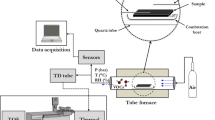Abstract
A gas standard mixture containing 22 chlorinated hydrocarbons in high purity nitrogen was prepared using a two-step weighing method and a gasifying apparatus developed in-house. The concentration of each component was determined using a gas chromatograph with flame ionization detection (GC/FID). Linear regression analysis of every component was performed using the gas standard mixture with concentrations ranging from 1 to 10 μmol/mol, showing the complete gasification of volatile organic compound (VOCs) species in a selected cylinder. Repeatability was also examined to ensure the reliability of the preparation method. In addition, no significant difference was observed between domestic treated and imported treated cylinders, which were conducive to reduction of the cost of raw materials. Moreover, the results of stability testing at different pressures and long-term stability tests indicated that the gas standard at 1 μmol/mol level with relative expanded uncertainties of 5% was stable above 2 MPa for a minimum of 12 months. Finally, a quantity comparison was conducted between the gas standard and a commercial gas standard from Scott Specialty Gases (now Air Liquide America Specialty Gases). The excellent agreement of every species suggested the favorable accuracy of our gas standard. Therefore, this reference material can be applied to routine observation of VOCs and for other purposes.



Similar content being viewed by others
References
D'Andrea MA, Reddy GK (2016) Illness symptoms experienced by children exposed to benzene after a flaring incident at the BP refinery facility in Texas City. Clin Pediatr 55:1143–1151. doi:10.1177/0009922816641463
Gao F, Calatayud V, García-Breijo F, Reig-Armiñana J, Feng Z (2016) Effects of elevated ozone on physiological, anatomical and ultrastructural characteristics of four common urban tree species in China. Ecol Indic 67:367–379. doi:10.1016/j.ecolind.2016.03.012
Gong Y, Wei Y, Cheng J, Jiang T, Chen L, Xu B (2017) Health risk assessment and personal exposure to volatile organic compounds (VOCs) in metro carriages—a case study in Shanghai, China. Sci Total Environ 574:1432–1438. doi:10.1016/j.scitotenv.2016.08.072
He Q, Yan Y, Li H, Zhang Y, Chen L, Wang Y (2015) Characteristics and reactivity of volatile organic compounds from non-coal emission sources in China. Atmos Environ 115:153–162. doi:10.1016/j.atmosenv.2015.05.066
Lei T et al (2013) Pollution characteristics of ambient volatile organic compounds (VOCs) in the southeast coastal cities of China. Environmental of Science and Pollution Research 20:2603–2615
Li L, Xie S, Zeng L, Wu R, Li J (2015) Characteristics of volatile organic compounds and their role in ground-level ozone formation in the Beijing-Tianjin-Hebei region, China. Atmos Environ 113:247–254. doi:10.1016/j.atmosenv.2015.05.021
Ling ZH, Guo H, Cheng HR, Yu YF (2011) Sources of ambient volatile organic compounds and their contributions to photochemical ozone formation at a site in the Pearl River Delta, southern China. Environ Pollut 159:2310–2319. doi:10.1016/j.envpol.2011.05.001
Lyu XP, Chen N, Guo H, Zhang WH, Wang N, Wang Y, Liu M (2016) Ambient volatile organic compounds and their effect on ozone production in Wuhan, central China. Sci Total Environ 541:200–209. doi:10.1016/j.scitotenv.2015.09.093
Rhoderick GC (1997) Development of a fifteen component hydrocarbon gas standard reference material at 5 nmol/mol in nitrogen Fresenius. J Anal Chem 359:477–483
Rhoderick GC, Yen JH (2006) Development of a NIST standard reference material containing thirty volatile organic compounds at 5 nmol/mol in nitrogen. Anal Chem 78(9):3125–3132
Rhoderick GC, Zlellnski WL, Jr R, Miller W (1993) Gas standards containing halogenated compounds for atmospheric measurements. Environmental science & Technology 27:2849–2854
Rhoderick GC, Duewer DL, Ning L, Desirant K (2010) Hydrocarbon gas standards at the pmol/mol level to support ambient atmospheric measurements. Analytical Chmistry 82:859–867
Shao P, An J, Xin J, Wu F, Wang J, Ji D, Wang Y (2016) Source apportionment of VOCs and the contribution to photochemical ozone formation during summer in the typical industrial area in the Yangtze River Delta, China. Atmos Res 176-177:64–74. doi:10.1016/j.atmosres.2016.02.015
Sun J, Wu F, Hu B, Tang G, Zhang J, Wang Y (2016) VOC characteristics, emissions and contributions to SOA formation during hazy episodes. Atmos Environ 141:560–570. doi:10.1016/j.atmosenv.2016.06.060
Wang Q, Han Z, Wang T, Zhang R (2008) Impacts of biogenic emissions of VOC and NOx on tropospheric ozone during summertime in eastern China. Sci Total Environ 395:41–49. doi:10.1016/j.scitotenv.2008.01.059
Wei W, Cheng S, Li G, Wang G, Wang H (2014) Characteristics of ozone and ozone precursors (VOCs and NOx) around a petroleum refinery in Beijing, China. J Environ Sci 26:332–342. doi:10.1016/s1001-0742(13)60412-x
Wu R, Li J, Hao Y, Li Y, Zeng L, Xie S (2016) Evolution process and sources of ambient volatile organic compounds during a severe haze event in Beijing, China. Sci Total Environ 560-561:62–72. doi:10.1016/j.scitotenv.2016.04.030
Xie M et al (2016) Temporal characterization and regional contribution to O3 and NOx at an urban and a suburban site in Nanjing, China. Sci Total Environ 551-552:533–545. doi:10.1016/j.scitotenv.2016.02.047
Author information
Authors and Affiliations
Corresponding author
Additional information
Responsible editor: Philippe Garrigues
Rights and permissions
About this article
Cite this article
Li, N., Du, J., Yang, J. et al. Development of a standard reference material containing 22 chlorinated hydrocarbon gases at 1 μmol/mol in nitrogen. Environ Sci Pollut Res 24, 24177–24186 (2017). https://doi.org/10.1007/s11356-017-9774-y
Received:
Accepted:
Published:
Issue Date:
DOI: https://doi.org/10.1007/s11356-017-9774-y



